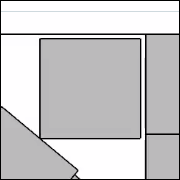|
kid sinister posted:Packing a valve is pretty easy. Basically, you turn off the water, open the valve as far as you can, take off the handle and packing nut then dig out the old packing. Next up is to either find a packing washer of appropriate size, or shove in some packing. It's string sized. Put everything back together in the right order and check for leaks. Yeah, says that in the specs if you click on the link (though not as strongly as you've worded it). Where did the OP specify his dryer is gas?
|
|
|
|

|
| # ? Jun 1, 2024 13:38 |
|
Friend posted:I would love to but the laundry room is in the middle of the house, surrounded by the living room, dining room, garage, and entry hall. Around here it has become fashionable to move the washer and dryer inside the house instead of having them in the garage. Aside from the potential for disaster of a washing machine malfunctioning or having a fill hose burst inside the house and possibly even on the second story, dryer ducting done well doesn't seem to happen very often. I've had to refer many people to an outfit that specializes in cleaning ducts because their dryer isn't working properly, but there is actually nothing wrong with the dryer itself.
|
|
|
|
Repo Man posted:Around here it has become fashionable to move the washer and dryer inside the house instead of having them in the garage. Aside from the potential for disaster of a washing machine malfunctioning or having a fill hose burst inside the house and possibly even on the second story, dryer ducting done well doesn't seem to happen very often. I've had to refer many people to an outfit that specializes in cleaning ducts because their dryer isn't working properly, but there is actually nothing wrong with the dryer itself. Around here having a washing machine or dryer in a garage would be a highly unusual choice. The main reason for this is that most garages are unheated and water lines would freeze in the winter. Most houses are designed with a special room for them that has proper flooring and a floor drain to handle accidents. Smart builders put the laundry room on an exterior wall so the dryer can vent directly without much ducting needed, but every once in a while you run into a dumb design (like the house I'm currently living in) and just have to deal with it.
|
|
|
|
Yeah our laundry room is kind of a mystery, because it also houses the pantry, but it neighbors the dining room, not the kitchen; and the dryer exhaust seems like an afterthought considering how sloppy the holes are. It was built in '84 though so it's not like they didn't know what a washer and dryer was.
|
|
|
|
Put in a fake fireplace in the living room and vent into there.
|
|
|
|
Friend posted:Yeah our laundry room is kind of a mystery, because it also houses the pantry, but it neighbors the dining room, not the kitchen; and the dryer exhaust seems like an afterthought considering how sloppy the holes are. It was built in '84 though so it's not like they didn't know what a washer and dryer was. So it shares a wall with the garage, which is where the washer/dryer should have be plumbed for. I'm assuming the plumbing is on the wall shared with the dining room? This is some stupid layout.
|
|
|
|
Mr. Mambold posted:So it shares a wall with the garage, which is where the washer/dryer should have be plumbed for. I'm assuming the plumbing is on the wall shared with the dining room? This is some stupid layout. Given the location of the washer in relation to the dryer it's more likely that the plumbing is on the wall shared with the living room. In my area it's against building code to put plumbing in a wall shared with a garage because the garage is again considered to be a cold zone and expected to be frozen for a good portion of the year. In the particular layout pictured I'm assuming that the dryer vents through the roof. My house is a duplex, with the laundry room on the lower level. The north wall of the laundry room is shared with the other unit of the duplex, the south wall has a door leading to a rec/family room, the plumbing is on the east wall shared with a bathroom and the west wall is shared with a bedroom. My dryer vents up to the ceiling and then runs around 25-30 feet through the floor joists and out the south side of the house.
|
|
|
|
Mr. Mambold posted:So it shares a wall with the garage, which is where the washer/dryer should have be plumbed for. I'm assuming the plumbing is on the wall shared with the dining room? This is some stupid layout. Yeah what PremiumSupport said, the exhaust goes straight up into the attic and then through the roof (or it will once I replace it), the plumbing is in the same wall, shared with the living room.
|
|
|
|
PremiumSupport posted:Given the location of the washer in relation to the dryer it's more likely that the plumbing is on the wall shared with the living room. In my area it's against building code to put plumbing in a wall shared with a garage because the garage is again considered to be a cold zone and expected to be frozen for a good portion of the year. In the particular layout pictured I'm assuming that the dryer vents through the roof. Right, I meant that. :arghh: The wall the washer and dryer are backed against. Ours is on an exterior wall, but it's got 2x6 framing, and not in a particularly cold zone, but Senator Inhofe tells us there is no such thing as global warming so 
|
|
|
|
Do we have a thread for asking questions about picking out home appliances like stoves and fridges? I have a bizarre middle class need for a new fridge.
|
|
|
|
Insane Totoro posted:Do we have a thread for asking questions about picking out home appliances like stoves and fridges? chat zone for house stuff https://forums.somethingawful.com/showthread.php?threadid=3770037 here's the CR best buy https://www.bestbuy.com/site/lg-23-6-cu-ft-french-door-refrigerator-stainless-steel/3044367.p?skuId=3044367 here's the wirecutter pick http://www.homedepot.com/p/Whirlpoo...0368321&cj=true I have the previous gen of that whirlpool, no complaints
|
|
|
|
Insane Totoro posted:Do we have a thread for asking questions about picking out home appliances like stoves and fridges? Check the warranty carefully - nothing like having a compressor fail on a unit that has a one year warranty (with nothing covered beyond the first year) when it's a little over a year old. It usually means you need a new fridge.
|
|
|
|
Qwijib0 posted:chat zone for house stuff Of those two, the LG has a far better warranty, with seven years on the sealed system and ten on the compressor, while the Whirlpool has one year full stop. Were I to purchase that Whirlpool fridge, I would also buy an extended warranty. That still might be the way to go, as I have no experience with LG appliances, but plenty with Whirlpool, and they've generally been good to at least fair. Stay far away from Frigidaire.
|
|
|
|
Looking for a little advice/confirmation on my options for a whole-home humidifier. Right now, I think I need something like the Aprilaire 700 series powered humidifier that doesn't need a leg running back into the ducting. My issue is that there's not really any room to mount a humidifier on the supply side, and even if I mount it on the return side, there's no room to run ducting back into the supply. Here's a pic of the Aprilaire 700 unit  Here's my ductwork  And a close up of the supply side showing how little room there really is  It doesn't show up well in the photo but the gap between the return and supply plenums is only maybe 3"
|
|
|
|
brugroffil posted:Looking for a little advice/confirmation on my options for a whole-home humidifier. Right now, I think I need something like the Aprilaire 700 series powered humidifier that doesn't need a leg running back into the ducting. It sounds like you probably want a steam humidifier instead, like the Aprailaire 800. What are your current humidity levels now? Depending on your climate, you might be better off air sealing the house, rather then adding a humidifier.
|
|
|
|
Qwijib0 posted:chat zone for house stuff Thanks but the fridge did a RIP sooner than I expected. Ended up with this one since I liked the design and it got good reviews. http://www.homedepot.com/p/GE-25-8-cu-ft-French-Door-Refrigerator-in-Slate-GFE26GMKES/206952366 Bought it at a good price from a local mom and pop with a good rep and they do their own warranty repairs.
|
|
|
|
devicenull posted:It sounds like you probably want a steam humidifier instead, like the Aprailaire 800. In the winter, very low, 20% maybe. I'm in the Chicago suburbs so plenty of natural gas heating throughout the winter.
|
|
|
|
I'm feeling a strong urge to install ethernet jacks in the various appropriate rooms of my house. I've never hosed with anything in it before and I'm just now learning that apparently the walls aren't filled with 'stuffing'. I'm looking for guides on how to actually make a wire go up one floor and across several rooms and I'm not quite getting it. Seems like I'm cutting holes in one place and feeding a long line down into it and then cutting another hole to grab that line, attach a wire, and pull it back. Is that it? When I have to go horizontal, I imagine that I'll be hitting 2x4s or whatever - I see super long drill bits, do I just make a hole? I'll have multiple wires so that doesn't sound quite right since I'd be looking at 3/4"-1" diameter for the hole to fit enough wires. Any good house noob guides to teach me how to not collapse the 2nd floor onto myself?
|
|
|
|
Running lines when the walls are already up is a pain in the rear end. Your best bet is to work your way from somewhere that is already accessible i.e. a crawlspace, attic, soffit if you get properly rated stuff. Avoid running in parallel to any power you got around, though most modern shielded stuff shouldn't see too much interference. Honestly, just be ready to cut holes in your drywall.
|
|
|
|
To expand on the topic, you want to go horizontal in crawlspaces, attics, soffits and only go vertical in walls* *unless you want to tear down your entire wall, drill appropriately small and centered holes in all your studs and then re-drywall, sand, and paint your entire house Ideally you will cut a hole in your drywall smaller than your low-voltage box cover plate so that when you place the wall-plate the entire hole is covered and you don't have to paint or patch anything. You should look into buying all your supplies from https://www.monoprice.com/ as it will be much cheaper than the same stuff purchased at Home Depot (like 10x or more cheaper). There are various guides out there on the internet with pictures, I looked at a few just now and disagreed with a few things on each so I'm not going to link any. Maybe someone else will have a guide they really like. my monoprice order posted:1040 Cat6 RJ-45 Toolless Keystone - Blue 4 $1.34 $5.36 To give you an idea of cost and this gave me way more than I needed. Additionally you will need an exacto knife or drywall saw for cutting the holes. A stud finder can be useful but not required if you are able to locate your studs without one. A drill with appropriate bits for whatever 2x4s (likely) you're needing to drill through to access your walls from the top or bottom. Some fish tape (string, metal tape, fiberglass push rods).
|
|
|
|
so... riddle me this. i have natural gas forced air heating in my house and it works well. since the house is 102 years old it was obviously a later retrofit. one result of this is that there aren't any ducts upstairs. there's one 'open' duct to a dead area inside the kitchen walls. obviously i don't want to install a vent fan if it's just going to be pulling up mouse poo poo. is there any way to easily split and or redirect an existing duct through dryer vent hose or something to the upstairs? it's not the biggest deal ever but if it gets decently cold this winter it's gonna suck.
|
|
|
|
brugroffil posted:Looking for a little advice/confirmation on my options for a whole-home humidifier. Right now, I think I need something like the Aprilaire 700 series powered humidifier that doesn't need a leg running back into the ducting. I'm glad you asked this, because I'm considering a humidifier as well. Thing is, we have two A/C units and the heat is via cast-iron radiators. My understanding is that we need steam-type humidification that calls on the A/C unit's air handler to start, like the Honeywell Advanced Electrode Humidifier? I'm also hoping that it's enough to do this only with the newer downstairs A/C, since it would integrate more easily and humid air rises. Edit: Also, would I need a goddamned water softener so as not to kill a humidifier? Because our water, she be hard.
|
|
|
|
Replacement dishwasher was just delivered. It didn't make sense to me to pay $20 for an "installation kit" from Home Depot since we're swapping out the existing unit, but are there any parts I should replace?
|
|
|
|
Josh Lyman posted:Replacement dishwasher was just delivered. It didn't make sense to me to pay $20 for an "installation kit" from Home Depot since we're swapping out the existing unit, but are there any parts I should replace? If you have a hard copper fill line, you're better off with a braided stainless one. Also, dishwashers are moving to a different standard for the fill line's fitting, so your old fill line may not work.  If you have an air gap, it's a good idea to replace it if it's old and crusty.
|
|
|
|
Josh Lyman posted:Replacement dishwasher was just delivered. It didn't make sense to me to pay $20 for an "installation kit" from Home Depot since we're swapping out the existing unit, but are there any parts I should replace? Pro tip for next time. Ask for the kit to be included for free. Worked for me buying from non big box appliance stores anyway.
|
|
|
|
I'm thirding giving a hard look at installing a whole-house humidifier this fall as our humidity drops to single digits when the furnace gets going during the cold months (October - April). Is there any reason not to plumb the drain line for it into the same line as my A/C condensate? Does this change if I'd like to build a system to recover/treat/store my condensate as part of a winter project? Do the drain lines on humidifiers constantly drip, or is it more of a safeguard?
Big Nubbins fucked around with this message at 18:35 on Oct 6, 2017 |
|
|
|
SoundMonkey posted:so... riddle me this. i have natural gas forced air heating in my house and it works well. since the house is 102 years old it was obviously a later retrofit. one result of this is that there aren't any ducts upstairs. there's one 'open' duct to a dead area inside the kitchen walls. obviously i don't want to install a vent fan if it's just going to be pulling up mouse poo poo. I don't know the right answer, but I knew some people who had a hundred year plus old house with a similar problem. What they did was just installed some some floor vents in the bedrooms directly to some ceiling vents on the lower level. No fans or anything. Then relied on the principle of heat rising to warm the upstairs. The upstairs was fine, though they had to keep the main floor a little too warm for my tastes to make it work. House hacks.
|
|
|
|
Shame Boner posted:I'm thirding giving a hard look at installing a whole-house humidifier this fall as our humidity drops to single digits when the furnace gets going during the cold months (October - April). Is there any reason not to plumb the drain line for it into the same line as my A/C condensate? Does this change if I'd like to build a system to recover/treat/store my condensate as part of a winter project? Do the drain lines on humidifiers constantly drip, or is it more of a safeguard? I don't know about the plumbing part, but my Aprilaire drains when it's running. I don't know if it was installed incorrectly or something, but it definitely goes through a lot of water when it's running.
|
|
|
|
I'm trying to remove and redo a badly-done line of silicone caulk where the tub connects to the floor. I live in a condo with a fiberglass tub and tiled floor. Each tile is about 1 square inch, so there are lots of little grooves to scrape stuff out of. The bathroom is about 9' x 4.5' with no window and connected to the bedroom. I have plans to remodel the whole thing next year, so it doesn't have to be beautiful, but I want to make sure it's sealed well in the meantime. The caulk is 100% silicone. I've cut out as much as I can with a razor, but there's a ton of residue. I'm trying to figure out the best way to remove that so I can put down the new stuff and be sure it will stick. I've seen the standard recommendations for loosening it: mineral spirits or denatured alcohol. Is one better than the other? Once I've got the caulk up, should I use anything other than a little soap and water to make sure I've removed any remaining solvent? My wife sometimes likes to light candles while she's in the bath, so I don't want it to start a fire if one gets knocked over. Since it's a small space with not-so-great ventilation, I'm a little concerned about fumes both while doing the work or afterwards when my wife and I are in bed. I can put a fan in the room and open a window in the bedroom, but I'm not sure if that's enough. Should I get a respirator? I've never used one before, so I'm not sure what to look for. Are there other alternative solvents I should look at instead? I always get a little nervous around chemicals any stronger than paint, so help is greatly appreciated.
|
|
|
|
Richard M Nixon posted:I'm feeling a strong urge to install ethernet jacks in the various appropriate rooms of my house. I've never hosed with anything in it before and I'm just now learning that apparently the walls aren't filled with 'stuffing'. I'm looking for guides on how to actually make a wire go up one floor and across several rooms and I'm not quite getting it. Get or make a gopher pole, do what the guy said about not going horizontal through walls, and go hog wild. You can make one from some thin pvc if you can't find a real one. You know how to do ethernet punchdowns too, right? Need a punch-on tool for that.
|
|
|
|
Jacquismo posted:I'm trying to remove and redo a badly-done line of silicone caulk where the tub connects to the floor. lol. It's a good thing you're in a condo and not a house. Don't overthink it. You don't need any PPE besides gloves. Acetone is the best solvent for silicone caulk. Alcohol is just a little too weak. Just be careful not to get it on your acrylic tub. You could lay a tape line to protect it. For applying the new caulk line, wear nitrile gloves and keep your finger clean and wet. I've tried laying tape lines and using non-ammonia aerosol window spray, and I much prefer the window spray technique. Google it.
|
|
|
|
Edit nm
Josh Lyman fucked around with this message at 22:33 on Oct 7, 2017 |
|
|
|
Keeping true to the thread title that I coined I just found a live outlet under some carpet I'm pulling up! This is the second time this has happened, and I'm expecting a hat trick.
|
|
|
|
Also, I'm pulling up this carpet in my living room. They put some put of board on top of the original hardwoods before putting the carpet down, and used a poo poo load of nails to secure it. I've tried going into my basement and playing whack a mole, but it's just too much work and some won't budge, wondering what my best options are here. It seems like if I rip out the board and am left with a little of the exposed nail, and try to pull it out from the top, it puts up a fight and chips the wood on its way out. Should I try wiggling it around a lot more before pulling out from up top? Alternately was wondering if I should do something like cut the nail heads off with a grinder and punching them down through the floor.
|
|
|
|
The Dave posted:Also, I'm pulling up this carpet in my living room. They put some put of board on top of the original hardwoods before putting the carpet down, and used a poo poo load of nails to secure it. I've tried going into my basement and playing whack a mole, but it's just too much work and some won't budge, wondering what my best options are here. It seems like if I rip out the board and am left with a little of the exposed nail, and try to pull it out from the top, it puts up a fight and chips the wood on its way out. Should I try wiggling it around a lot more before pulling out from up top? How big are the nail heads? If they're not too obtrusive, could you just hammer them flat? Otherwise, I'd just cut the heads and use a nail set to push them just below the surface. No need to push them the whole way through, the hole would probably be more obvious than the nail remnant.
|
|
|
|
Cut + Punch makes sense to me but maybe the head of the nails aren't big enough to not just punch with them.
The Dave fucked around with this message at 21:08 on Oct 8, 2017 |
|
|
|
The Dave posted:I'm a little nervous I'm going to bang the poo poo out of the floors if I just hammer them down, also shouldn't they be a little below the surface for the sander? Cut + Nail Punch is starting to make a lot of sense to me. Yeah, just a hammer is going to beat up the floors -- as long as the heads aren't distractingly big I'd use a nail set on them to get them in enough for the sander and leave 'em, and if they ARE distractingly big, .. I'd cut the head then then use a nail set on them. Basically, I wouldn't sweat the extra nails in the floor if removing them was tearing up the wood. If the nail holes aren't too noticeable and the access from the bottom of the floor is good, I'd also consider cutting of the heads and then using vice grips to rip the nails out from beneath. As context, please don't take any advice from me as an endorsement for the correct thing to do, it's just what I would do.
|
|
|
|
The Dave posted:Also, I'm pulling up this carpet in my living room. They put some put of board on top of the original hardwoods before putting the carpet down, and used a poo poo load of nails to secure it. I've tried going into my basement and playing whack a mole, but it's just too much work and some won't budge, wondering what my best options are here. It seems like if I rip out the board and am left with a little of the exposed nail, and try to pull it out from the top, it puts up a fight and chips the wood on its way out. Should I try wiggling it around a lot more before pulling out from up top? Are you just putting more carpet down? I thought carpet guys usually just staple the pad to the hardwood, so I'm not familiar with the board you are talking about being on top. I have been pulling the enormous amount of plywood storage sheets out of my attic with a shark bar in order to blow in insulation. If the nails have a head on them and aren't brads it should work well I would think. You just tap it with a hammer and it bites into the board under the nail head and you can pry them out. https://www.amazon.com/Shark-21-2225-10-Inch-Prybar-Puller/dp/B0000224TY
|
|
|
|
Nah gonna be restoring the original floors. I really donít know what kind of material it is, but itíll be interesting to find out why they used it because they didnít when they carpeted the upstairs. Either way hello 200 year olds hardwoods. About six/seven inch wide planks, we refinished them in another room and theyíre so god drat good looking. Now the other room I wanted to get to has some weird vinyl flooring on it that Iím not touching until I get it tested for asbestos, hoping the glue isnít a nightmare to get off. 
|
|
|
|

|
| # ? Jun 1, 2024 13:38 |
|
The Dave posted:Now the other room I wanted to get to has some weird vinyl flooring on it that Iím not touching until I get it tested for asbestos, hoping the glue isnít a nightmare to get off. The vinyl tiles aren't so bad, but the stuff you are taking up in that picture doesn't look like a wood product. And does look to be friable. e: (and a bitch to get up!) HycoCam fucked around with this message at 03:30 on Oct 9, 2017 |
|
|




































